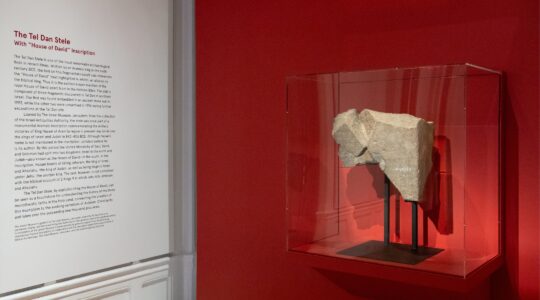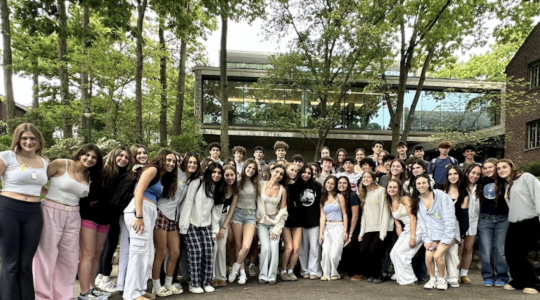Few ethnic groups in New York feel at once as visible, and invisible, as chasidim. Their garb — long black coats for men and long, modest dresses and wigs for women — makes them stick out even in the city’s rainbow diversity. Yet they are often seen only as stereotypes — bad landlords, anti-vaxxers, victims of urban crime in their Brooklyn neighborhoods.
Pop culture portrayals often haven’t helped. There was the dull campiness of 1981’s “The Chosen” (based on Chaim Potok’s book), then the flat-out inaccuracy of “A Price Among Rubies” from the ’90s and 2006’s inane and preposterous “Holy Rollers,” starring Jesse Eisenberg. One American film stands out, the recent Yiddish dramedy “Menashe.” It was thoughtfully produced and was the first time a film offered chasidim the chance to show emotional complexity, instead of simply being boorish or endlessly quoting Talmud.
Enter “Hasidim on the Beach,” an exhibition of photographs by Judy Mauer at Bed-Stuy’s The Bishop Gallery that focuses on Brooklyn’s chasidic community and its families on Sea Gate Beach. (The show runs through Nov. 2.) The gallery location is important, as Bed-Stuy is rapidly gentrifying and New York’s newer residents might ignore or harbor strong feelings about the area’s native chasidic population. Mauer’s images humanize them. Indeed, the exhibition attempts to bridge the gap between chasidim and their neighbors. There will be programming that involves members of the chasidic community, including artists, business owners and even a rabbi.
Mauer, the grandchild of refugees from European pogroms, was born in Brooklyn and currently lives in the borough’s Sea Gate neighborhood. At times in her photographs, the chasidim are the subject, and at times they are the object. As a viewer I felt a bit uneasy at times, as the subjects seem to lack agency. In one photograph, “cooling off,” women are seen in long robes and tichels, or headscarves, standing in the shallow end of the beach with their feet in the water. Do they know they are being photographed? They are clearly modest — would they be comfortable knowing that they are on display in a gallery in front of gentiles who might harbor judgmental ideas?
Some photos are more whimsical, such as the one of men in white socks dancing, facing the waves while a smiling girl of 5 years old faces the other way, wearing a blue dress. The juxtaposition of color and the girl’s clear happiness is striking. A woman’s wig, topped with a cute bow, rests on a rock. At first glance, I thought the woman herself had been cropped out; she must have been going for a dip. Another image tells the story of a family that seems to take over a large white lifeguard chair. Mauer told me she befriended one of the women.
Some images are tender, showing the humanity of a parent’s love for his child. A man holds his toddler daughter on his lap, hugging her, his car keys and cell phone far away from him on a rock; the viewer doesn’t know if she was just crying or the father just wanted to be close to her. Another image shows young teenage girls in long modest skirts and school uniform shirts in the water.
I hope the collection challenges the viewers’ assumptions. Unfortunately, the show misses the nuance between Orthodox communities.
Last summer, I was in north Tel Aviv, walking on an empty beach on Friday at 1 a.m. I passed some chasidim, their tzitzit strings flying in the wind. They were drinking beer from Eastern Europe and invited me to join them. They were from the charedi town of Bnei Brak and shared with me their food and drink. Over the next hour, I learned that they have read Stephen Hawking and Yuval Noah Harari. I left inebriated from the interaction — that despite their outer trappings, they have intellectual interests that buck any ideas one might have about them. I’m unsure if a visitor to Maurer’s show would leave with the same perception.
That said, one of the founders of The Bishop, Stevenson Dunn, is a Muslim of color who believes that art can build bridges between Jews and people of color. Over a phone call, he described workshopping the idea of the photo show with his Jewish store-owning neighbors, such as the owner of a print shop he patronizes. They liked the idea, and he scheduled the opening so that the High Holidays would not be in conflict with them. Indeed, a local Chabad rabbi will be in conversation with Mauer at one event. Dunn hoped that the gentrifying hipsters might see this collaboration as a sign: perhaps art can be aspirational and build a more perfect union in this country. At least on one small corner of Bed-Stuy.
Eli Reiter’s column appears monthly.
The New York Jewish Week brings you the stories behind the headlines, keeping you connected to Jewish life in New York. Help sustain the reporting you trust by donating today.




